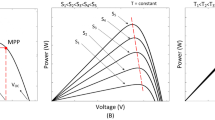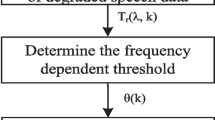Abstract
Adaptive filters have become active research area in the field of communication system. This paper investigates the innovative concept of adaptive noise cancellation (ANC) using cascaded form of least-mean-square (LMS) adaptive filters. The concept of cascading and its algorithm for real-time LMS-ANC are also described in detail. The model of the cascaded LMS-ANC is designed and simulated on MATLAB Simulink. The simulation model gives variation in the distinct signals of LMS-ANC like error, output and weights at various LMS filter parameters. The proposed algorithm utilizes two adaptive filters to estimate gradients accurately and results in good adaptation and performance. The objective of the present investigation is to provide solution in order to improve the performance of noise canceller in terms of filter parameters. The results are obtained with the help of adaptive algorithm with variable step size and different initial weight of filters which provides high convergence speed of error signal. This paper also includes the derivation for the convergence rate at different conditions and concludes that cascaded LMS-ANC results in higher convergence rate and better output signal as compared to single LMS-ANC. Higher signal-to-noise ratio for cascaded system is obtained for cascaded LMS-ANC as compared to that of single LMS-ANC system.



















Similar content being viewed by others
References
M.S.E. Abadi, J. Husoy, Mean-square performance of adaptive filter algorithms in non-stationary environments. Int. J. Signal Process. 2, 182–188 (2008)
N. Ahmed, D. Hush, G.R. Elliot, R.J. Fogler, Detection of multiple sinusoids using an adaptive cascaded structure. IEEE Int. Conf. Acoust. Speech Signal Process. 9, 199–202 (1984)
D.J. Allred, H. Yoo, V. Krishnan, W. Huang, D.V. Anderson, LMS adaptive filters using distributed arithmetic for high throughput. IEEE Trans. Circuits Syst. I 52(7), 1327–1337 (2005)
M. Baes, Digital Signal Processing with Field Programmable Gate Arrays (Springer, Berlin, 2007)
J. Brocker, U. Parlitz, M. Ogorzałek, Nonlinear noise reduction. Proc. IEEE 90(5), 898–918 (2002)
S.G. Chen, Y.A. Kao, K.Y. Tsai, A new efficient LMS adaptive filtering algorithm. IEEE Trans. Circuits Syst. II Analog Digit. Signal Process. 43(5), 372–378 (1996)
M.R. Cowper, B. Mulgrew, in The application of a nonlinear inverse noise cancellation technique to maritime surveillance radar, 10th IEEE Workshop on Statistical Signal and Array Processing, (2000), pp. 267–271
G.M. Davis, Noise Reduction in Speech Applications (CRC Press, Boca Raton, 2002)
S.C. Douglas, Performance comparison of two implementations of the leaky LMS adaptive filter. IEEE Trans. Signal Process. 45(8), 2125–2129 (1997)
S.C. Douglas, W. Pan, Exact expectation analysis of the LMS adaptive filter. IEEE Trans. Signal Process. 43(12), 2863–2871 (1995)
A.J. Efron, L.C. Han, Wide-area adaptive active noise cancellation. IEEE Trans. Circuits Syst. II Analog Digit. Signal Process. 41(6), 405–409 (1994)
B.J. Farahani, M. Ismail, Adaptive noise cancellation techniques in sigma–delta analog-to-digital converters. IEEE Trans. Circuits Syst. I 54(9), 1891–1899 (2007)
S.S. Godbole, P.M. Palsodkar, V.P. Raut, in FPGA implementation of adaptive LMS filter, Proceedings of SPIT-IEEE Colloquium and International Conference, India, (2), pp. 2226–2229
D.Y. Huang, S. Rahardja, in The misadjustment of the cascaded LMS prediction filter, IEEE International Symposium on Circuits and Systems, (2009), pp. 2565–2568
J.H. Husoy, M.S.E. Abadi, Unified approach to adaptive filters and their performance. IET Signal Proc. 2(2), 97–109 (2008)
M.N.S. Jahromi, A. Hocanin, O. Kukrer, M.S. Salman, in Two dimensional zero-attracting variable step-size LMS algorithm for sparse system identification, 21st Signal Processing and Communications Applications Conference, Haspolat, (2013), pp. 1–3
N. Kalyanasundaram, P. Palanisamy, Target detection by adaptive noise cancellation. Electron. Lett. 44, 1–2 (2008)
W. Kester, Mixed Signal and DSP Design Techniques (Newnes, 2003)
J. Krolik, N. Joy, S. Pasupathy, M. Eizenman, A comparative study of the adaptive filter versus generalized correlation methods for time delay estimation. IEEE Int. Conf. Acoust. Speech Signal Process. 9, 652–655 (1984)
S.M. Kuo, B.H. Lee, Real Time Digital Signal Processing (Wiley, New York, 2001)
T. Lan, J. Zhang, in FPGA implementation of an adaptive noise canceller, IEEE International Symposiums on Information Processing, (2008), pp. 553–558
W.B. Lopes, C.G. Lopes, in Incremental combination of RLS and LMS adaptive filters in nonstationary scenarios, IEEE International Conference on Acoustics, Speech and Signal Processing, Canada, (2013), pp. 5676–5680
Z. Lu, G. Hu, X. Wang, L. Yang, in An improved adaptive Wiener filtering algorithm, International Conference on Signal Processing, (2006), pp. 1–4
V.K. Madisetti, D.B. Williams, Digital Signal Processing Handbook (CRC Press, Boca Raton, 1999)
K. Matsubara, K. Nishikawa, H. Kiya, Pipelined LMS adaptive filter using a new look-ahead transformation. IEEE Trans. Circuits Syst. II Analog Digit. Signal Process. 46(1), 51–55 (1999)
H. Modares, A. Ahmadyfard, M. Hadadzarif, in A PSO approach for non-linear active noise cancellation, Proceedings of the 6th WSEAS International Conference on Simulation, Modeling & Optimization, Lisbon, Portugal, (2006), pp. 492–497
B. Mulgrewt, P. Strauchtt, in Nonlinear Dynamics and Noise Cancellation, The Institution of Electrical Engineers, 2/1-2/6 (1997)
A.O. Ogunfunmi, in Performance analysis of a new implementation for the frequency-domain LMS adaptive filter, 34th Midwest Symposium on Circuits and Systems, (1991), pp. 501–504
T.O. Onur, R. Hacioglu, in Adaptive echo and noise cancellation for car hands-free voice communication, 21st Signal Processing and Communications Applications Conference, (2013), pp. 1–4
L. Rugini, G. Leus, in Basis expansion adaptive filters for time-varying system identification, 2nd IEEE International Workshop on Computational Advances in Multi-Sensor Adaptive Processing, (2007), pp. 153–156
G.K. Sang, D. Yoo Chang, Q. Nguyen Truong, Alias-free subband adaptive filtering with critical sampling. IEEE Trans. Signal Process. 56(5), 1894–1904 (2008)
G.J. Saulniert, P. Das., in Antijam spread spectrum receiver using LMS adaptive filtering techniques, IEEE Military Communications Conference, (1984), pp. 482–487
G. Saxena, S. Ganesan, M. Das, in Real time implementation of adaptive noise cancellation, IEEE International Conference on Electro/Information Technology, (2008), pp. 431–436
S.W. Smith, Digital Signal Processing (California Technical publishing, Poway, 1999)
S. Stergiopoulos, Advanced Digital Signal Processing Handbook (CRC Press, Boca Raton, 2001)
P. Strobach, Low rank adaptive filters. IEEE Trans. Signal Process. 44(12), 2832–2947 (1996)
X. Sun, S.M. Kuo, Active narrowband noise control systems using cascading adaptive filters. IEEE Trans. Audio Speech Lang. Process. 15(2), 586–592 (2007)
L. Tao, H.K. Kwan, in A neural network method for adaptive noise cancellation, IEEE International Symposium on Circuits and Systems, (1999), pp. 567–570
J. Tapia, S.M. Kuo, in An optimized automatic gain controller for real-time recursive LMS adaptive filters, IEEE International Symposium on Circuits and Systems, (1990), pp. 3154–3157
R.J. Tony, RF and Digital Signal Processing for Software-Defined Radio, 1st edn. (Newnes, 2008)
Z. Udo, Digital Audio Signal Processing (Wiley, New York, 2008)
E. Ugur, M. Secmen, N. Ozkurt, in The comparison of LMS based algorithms for active cancellation of motor noise, 21st Signal Processing and Communications Applications Conference, Haspolat, (2013), pp. 1–4
S.V. Vaseghi, Advanced Digital Signal Processing and Noise Reduction (Wiely, New York, 2000)
B. Widrow, J.R. Glover, J.M. Mccool, J. Kaunitz, C.S. Williams, R.H. Hean, J.R. Zeidler, E. Dong, R.C. Goodlin, Adaptive noise cancelling: principles and applications. Proc. IEEE 63(12), 1692–1716 (1975)
Y. Xia, L. Jianchang, L. Hongru, in Performance analysis of adaptive filters for time-varying systems, 32nd Chinese Control Conference, Xi’an, (2013), pp. 8572–8575
J. Yuzhong, R.Y.P. Cheung, W.W.Y. Chow, M.P.C. Mok, in A novel gradient adaptive step size LMS algorithm with dual adaptive filters, 35th Annual International Conference of the IEEE Engineering in Medicine and Biology Society, Osaka, (2013), pp. 4803–4806
Author information
Authors and Affiliations
Corresponding author
Appendix: Step-size positions
Appendix: Step-size positions
Step-size position | Step size of first LMS filter (\(\upmu _{1})\) | Step size of second LMS filter (\(\upmu _{2})\) |
|---|---|---|
1 | 1 | 1 |
2 | 0.9 | 1 |
3 | 0.8 | 1 |
4 | 0.7 | 1 |
5 | 0.6 | 1 |
6 | 0.5 | 1 |
7 | 0.4 | 1 |
8 | 0.3 | 1 |
9 | 0.2 | 1 |
10 | 0.1 | 1 |
11 | 0.05 | 1 |
12 | 1 | 0.9 |
13 | 0.9 | 0.9 |
14 | 0.8 | 0.9 |
15 | 0.7 | 0.9 |
16 | 0.6 | 0.9 |
17 | 0.5 | 0.9 |
18 | 0.4 | 0.9 |
19 | 0.3 | 0.9 |
20 | 0.2 | 0.9 |
21 | 0.1 | 0.9 |
22 | 0.05 | 0.9 |
23 | 1 | 0.8 |
24 | 0.9 | 0.8 |
25 | 0.8 | 0.8 |
26 | 0.7 | 0.8 |
27 | 0.6 | 0.8 |
28 | 0.5 | 0.8 |
29 | 0.4 | 0.8 |
30 | 0.3 | 0.8 |
31 | 0.2 | 0.8 |
32 | 0.1 | 0.8 |
33 | 0.05 | 0.8 |
34 | 1 | 0.7 |
35 | 0.9 | 0.7 |
36 | 0.8 | 0.7 |
37 | 0.7 | 0.7 |
38 | 0.6 | 0.7 |
39 | 0.5 | 0.7 |
40 | 0.4 | 0.7 |
41 | 0.3 | 0.7 |
42 | 0.2 | 0.7 |
43 | 0.1 | 0.7 |
44 | 0.05 | 0.7 |
45 | 1 | 0.6 |
46 | 0.9 | 0.6 |
47 | 0.8 | 0.6 |
48 | 0.7 | 0.6 |
49 | 0.6 | 0.6 |
50 | 0.5 | 0.6 |
51 | 0.4 | 0.6 |
52 | 0.3 | 0.6 |
53 | 0.2 | 0.6 |
54 | 0.1 | 0.6 |
55 | 0.05 | 0.6 |
56 | 1 | 0.5 |
57 | 0.9 | 0.5 |
58 | 0.8 | 0.5 |
59 | 0.7 | 0.5 |
60 | 0.6 | 0.5 |
61 | 0.5 | 0.5 |
62 | 0.4 | 0.5 |
63 | 0.3 | 0.5 |
64 | 0.2 | 0.5 |
65 | 0.1 | 0.5 |
66 | 0.05 | 0.5 |
67 | 1 | 0.4 |
68 | 0.9 | 0.4 |
69 | 0.8 | 0.4 |
70 | 0.7 | 0.4 |
71 | 0.6 | 0.4 |
72 | 0.5 | 0.4 |
73 | 0.4 | 0.4 |
74 | 0.3 | 0.4 |
75 | 0.2 | 0.4 |
76 | 0.1 | 0.4 |
77 | 0.05 | 0.4 |
78 | 1 | 0.3 |
79 | 0.9 | 0.3 |
80 | 0.8 | 0.3 |
81 | 0.7 | 0.3 |
82 | 0.6 | 0.3 |
83 | 0.5 | 0.3 |
84 | 0.4 | 0.3 |
85 | 0.3 | 0.3 |
86 | 0.2 | 0.3 |
87 | 0.1 | 0.3 |
88 | 0.05 | 0.3 |
89 | 1 | 0.2 |
90 | 0.9 | 0.2 |
91 | 0.8 | 0.2 |
92 | 0.7 | 0.2 |
93 | 0.6 | 0.2 |
94 | 0.5 | 0.2 |
95 | 0.4 | 0.2 |
96 | 0.3 | 0.2 |
97 | 0.2 | 0.2 |
98 | 0.1 | 0.2 |
99 | 0.05 | 0.2 |
100 | 1 | 0.1 |
101 | 0.9 | 0.1 |
102 | 0.8 | 0.1 |
103 | 0.7 | 0.1 |
104 | 0.6 | 0.1 |
105 | 0.5 | 0.1 |
106 | 0.4 | 0.1 |
107 | 0.3 | 0.1 |
108 | 0.2 | 0.1 |
109 | 0.1 | 0.1 |
110 | 0.05 | 0.1 |
111 | 1 | 0.05 |
112 | 0.9 | 0.05 |
113 | 0.8 | 0.05 |
114 | 0.7 | 0.05 |
115 | 0.6 | 0.05 |
116 | 0.5 | 0.05 |
117 | 0.4 | 0.05 |
118 | 0.3 | 0.05 |
119 | 0.2 | 0.05 |
120 | 0.1 | 0.05 |
121 | 0.05 | 0.05 |
Rights and permissions
About this article
Cite this article
Dixit, S., Nagaria, D. Design and Analysis of Cascaded LMS Adaptive Filters for Noise Cancellation. Circuits Syst Signal Process 36, 742–766 (2017). https://doi.org/10.1007/s00034-016-0332-5
Received:
Revised:
Accepted:
Published:
Issue Date:
DOI: https://doi.org/10.1007/s00034-016-0332-5




